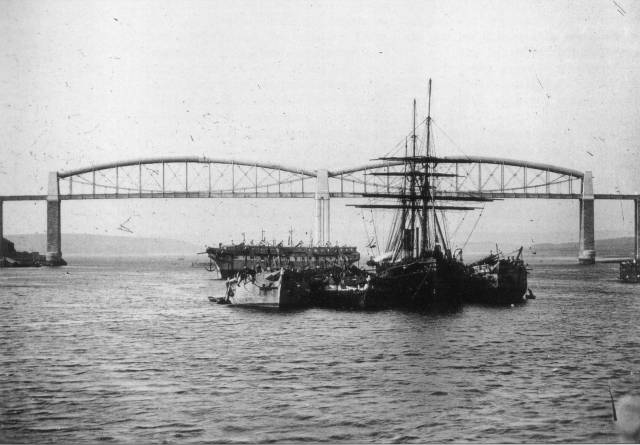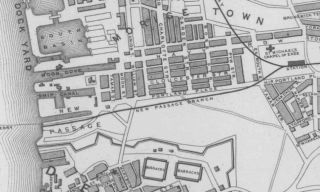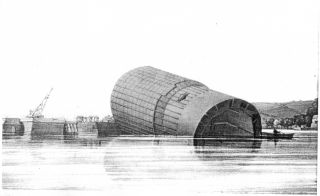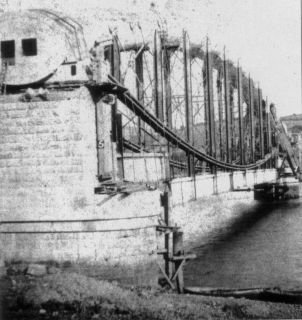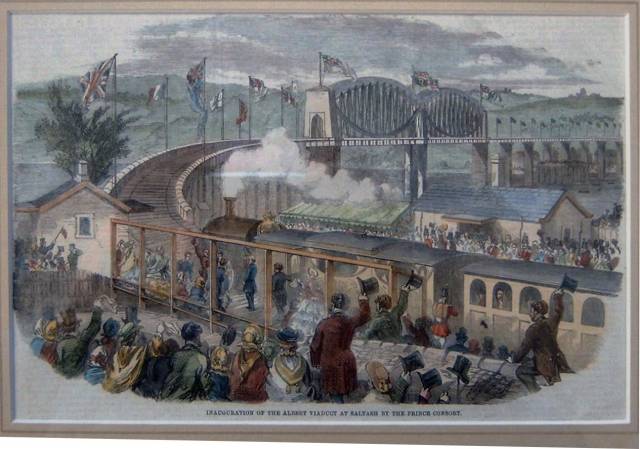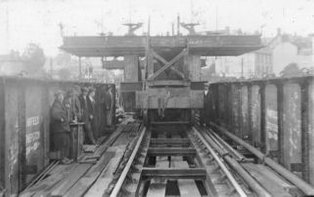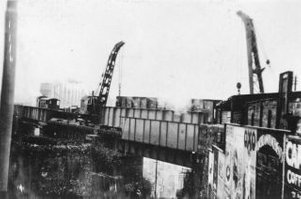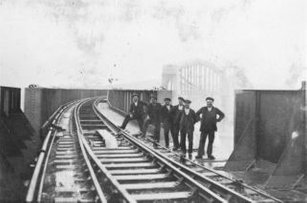Royal Albert Bridge
The Royal Albert Bridge 1861
The RoyalAlbertBridge is now regarded as a national treasure and the predominant landmark of Saltash, but the plan to build a bridge at Saltash had competition. The first plan put forward was a line surveyed by Captain William Scarth Moorsom for the Cornwall Railway (CR) and was to cross the river at Torpoint then follow the path of what is now the A374 towards Polbathic and Trerulefoot.
When this bill was deposited for the 1845 session of Parliament the promoters were surprised to find another bill sponsored by the ‘Devon and Cornwall Central Railway’, supported by the LSWR had also been deposited. This was for a line from Exeter to Falmouth via Okehampton and Bodmin. (Both companies saw Falmouth as the primary destination, being the third largest deep water port in the world).
The Cornwall Railway plan won the day. The D&CCR plan was thrown out by the House of Commons on the ground of ‘Lack of commercial benefit and difficult to engineer due to high embankments’, they seemed to overlook the engineering challenge the CR would face in crossing the Tamar by ferry and overcoming the tight bends and steep gradients on route.
Fortunately for Saltash the Cornwall Railway’s plan was thrown out by the House of Lords who recommended the route be re-surveyed. The CR brought in IK Brunel, the engineer for the Great Western Railway (GWR) and the South Devon railway (SDR) to replace Captain Moorsom. Brunel advocated a line from a junction with the SDR at Devonport crossing the Tamar by a high level bridge at Saltash and then via St. Germans to join the original planned route. The bridge over the Tamar was to have no more than four spans and had to be approved by the Admiralty. The new plan was re-submitted to Parliament and after a fight received Royal Assent on the 3rd August 1846. Broad gauge was to be used throughout and the existing standard gauge West Cornwall Railway (WCR) lines were to be converted to dual gauge.
Brunel toyed with a number of ideas for crossing the Tamar but his options were limited by the Admiralty’s requirement for 100ft clearance and the lack of natural rock or hard ground mid stream. He called on his own experience gained when building the bridge over the river Wye at Chepstow and that of his friend, Stephenson who had built the Britannia tubular bridge over the Menai Straights. Brunel finally decided on a suspension bridge of two spans each of 455ft and seventeen approach spans (seven on the Devon side and ten on the Cornwall side)
Everything hinged on finding rock in the bed of the Tamar to support the weight of the centre pier and both spans. This Brunel did by standing an 85ft tube vertical in mid-stream and carrying out a large number of borings into the river bed to find the best location for the centre pier. This was completed by early 1849 and a trial foundation laid. In 1853 a contract to build the bridge was awarded to the firm of C.J. Mare but they went bankrupt in 1885 Brunel decided to supervise the building of the bridge himself.
Foundations
A huge cylinder was constructed on shore, 95ft long, 35ft in diameter and weighing 300tons. By February 1855 the cylinder had been floated into position and stood upright on the river bed. The lower section contained a pressurised work area where, after all the mud had been removed, the rock was excavated for three feet before construction of the foundations began. Construction of the main pier continued until the end of 1856 when it was capped at 12 ft above the high water line, the upper sections of the coffer dam, which had been constructed in two halves, were then removed.
Centre Column
While the centre column foundations were being built work was progressing on the construction of the western span. This was carried out in a temporary dock built on the Devon bank of the river, each span was to be 455ft long and weigh 1060 tons. These spans were to be supported on granite and limestone pillars on the land sides and in the centre of the river supported on four cast iron octagonal columns (two per span). When complete each column would weigh 100 tons and be 100ft tall. Each column was constructed in 6ft sections which were lifted into place to support the spans as they were raised by huge hydraulic jacks.
As the columns were raised cross braces were fitted so that they would strengthen and support each other.
Main Spans
The first span to be completed was the Saltash span. Two pontoons with sealed hulls were constructed and floated into docks excavated below each end of the truss, valves were opened and the pontoons flooded until they came to rest on the dock bottom. A timber frame was built on each pontoon capable of supporting the weight of the truss. The date was set for Tuesday 1 September 1857. The night before at low tide valves were opened to drain the water from the pontoons. As the tide came in the pontoons floated and by 1pm the truss was clear, it was slowly towed into the middle of the river and swung round 90°, by 3pm the truss had been edged into position between the centre and western pier and the valves opened allowing the pontoons to sink and the truss to settle onto the piers. The operation was watched by a large crowd of 30 – 40,000 and many official guests. A public holiday was declared in Saltash, tents and marquees were erected with much food and drink consumed.
Opening Day
The bridge was opened by His Royal Highness Prince Albert (who had given his permission for the bridge to be called ‘Royal Albert Bridge’) on Monday 2nd May 1859.
In preparation for the opening a platform was built on the Devon side of the bridge. A military band and guard with a battery of artillery were gathered with dignitaries from all over Devon and Cornwall. Special trains were laid on to bring guests and observers to the bridge, unfortunately the special train from Truro broke down at Liskeard causing the Mayor of Truro and his guests to miss the proceedings.
The royal train was due to reach Saltash at 12 noon, the driver given the honour of driving the train was Thomas Tunstall who a few week earlier had driven the first test train over the bridge, Daniel Gooch, the locomotive superintendent of the GWR, was also on the footplate.
The train stopped at the specially constructed platform where His Royal Highness was received by the Earl of Mount Edgcumbe and other dignitaries, an address was given by the Mayor of Saltash before His Royal Highness and party boarded the train and slowly crossed the bridge.
Raising the Span
Raising the Saltash span 100ft took until May 1858 (an average of 6ft per week). Hydraulic jacks were used to alternately raise each end 3ft at a time, the Saltash pier being built up with limestone after each lift while on the centre pier a new 6ft section of hexagonal ironwork was added to each column after every second lift.
Constuction of the Devon span took eight months, a lot quicker than the Cornish span but in the time since the Cornish span had been floated out, the base of the Devon span pier had been constructed, making this manouvre more difficult.
Constuction was complete by 30 June 1858 and the date for moving the span into position between the piers was set for Saturday 10 July 1858. Brunel was in poor health and was spending time in the dry heat of Egypt so the whole operation was carried out under the direction of R.P. Brereton who had assumed control in Brunel’s absence.
At about 2pm the span was afloat and gradually moved out from its construction stage, it was warped up stream to clear the Devon pier before being turned across the river and gradually inched into place, the ends of the span finally being located on the piers at about 5pm.
The lift began on 9 August and by 28 December 1858 the truss had been lifted 98ft to match the Cornish span.
The occasion was celebrated by the management and work force unfurling the Royal Standard on top of the arch and giving three cheers.
At Saltash the crowd cheered as the train slowly passed through the station before stopping at Coombe Viaduct where the royal party examined the construction of the timber viaduct before returning to Saltash Station where the royal visitor left his carriage and with specially invited guests walked across the bridge back to the Devon side. He then declared the bridge open to much cheering and applause. Brunel could not attend the opening due to failing health.
The opening ceremony now over the royal party descended to the bridge works on the Devon bank of the Tamar to examine the plans and meet the directors of the Cornwall Railway before retiring to a marquee for lunch.
In the afternoon the royal party embarked on the Admiralty yacht Vivid to view the bridge from the river before cruising up the St Germans River. They returned via Mount Edgcumbe Park to re-embarked on the Vivid at Cawsand, crossing to Royal William Yard en route to Millbay Station where the royal train was waiting to return the party to Windsor.
The Cornwall Railway was officially opened throughout from Millbay to Truro the next day by the directors of the company. The Cornwall Railway had previously purchased the branch line from Millbay to Devonport from the South Devon Railway with the agreement that Milbay Station would become a joint enterprise.
Tribute to Brunel
Later in May Brunel who was now very weak and failing health returned to Britain and arrangements were made for him to see his completed bridge. His friend Daniel Gooch organised for a coach to be mounted on a flat trolley and a locomotive to pull the trolley slowly across the bridge. Brunel then returned home where he died surrounded by his family on 15 September 1859.
As a tribute to Brunel the directors of the Cornwall Railway decided to have the lettering:
I K BRUNEL
1859
ENGINEER
set on the portals at each end of the bridge.
The whole cost of constructing the bridge, including the cost of the foundations for the centre pier which were 85ft below high water was £225,000. A remarkably low price, even in 1859 for bridging the Tamar
From 1859
When built the bridge was painted a very light grey. At the first repaint in July 1867 the centre column was painted granite colour and the spans painted brown. In April 1868 the Brunel lettering at each end of the bridge was painted white at a cost of £2.
The Cornwall Railway had no set time period for painting the bridge, money seems to have been a guiding factor with the paintwork frequently touched up and a complete repaint only when necessary. The quality of paint at the time was not of today’s standard and in 1874 it was reported that a repaint was urgently required. In 1882 and 1886 the upper part above the chains was painted and in 1887 all parts below the chains were painted. When the CR was amalgamated into the GWR in 1889 a system was put into place where the bridge was painted every five years.
The weight of trains had been gradually increasing since the opening in 1859, and from 1900 to 1905 a total of 401 new cross girders were fitted between the existing girders.
In 1908 as part of the improvements to Saltash Station the two land spans on the Cornwall side next to the station were replaced with wider spans to enabling the points to be moved onto the spans, allowing greater use to be made of the platforms. In 1909 the water main from Burraton Reservoir was re-laid across the bridge.
In 1927 a report was made saying corrosion on the ends of the land span girders meant that they were no longer at their original strength. After a year of planning the spans were replaced in 1928/29 (see ‘Renewal of the spans’).
By the late 1930’s new and heavier locomotives were being delivered to the GWR requiring further strengthening of the two main spans. This was done by adding additional steel cross bracing to the original diagonal cross bracing and adding additional fixings between the chains and the roadway.
During WW2 sleepers were laid between and alongside the tracks across the bridge to enable military vehicles to cross but there is no record that they were ever used
In 1950 the Devon span was struck by the masts of HMS Roberts which broke off but the bridge sustained no damage.
In 1959 for the centenary the bridge received a fresh coat of paint and was floodlit.
The most recent major modification came in 1970 following an assessment in the late 1960s of the bridge's capacity to take proposed new wagons with increased axle loads of 25t. Tests on a model led to the discovery of peculiar behaviour, attributed to interaction between the chains and the track girder. Distortion of the quadrilateral formed by two adjacent hangers, the track girder and the chain caused considerable secondary bending in the section of hanger below the chain. To eliminate this additional pre-tensioned diagonals were added to limit the secondary bending.
The work enabled English China Clays to use 47t rather than 30t two axle vehicles, and 80t four axle vehicles.
One side effect of the strengthening work carried out is that GWR King class steam locomotives can for the first time cross the bridge and run on Cornish metals.
In 1987 it was reported that about £80,000 would be spent annually on routine maintenance.
The bridge is now fitted with strain gauges which continually monitor any movement.
